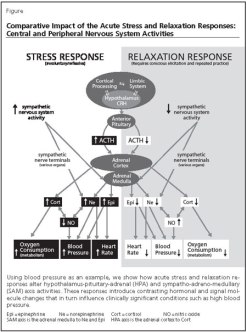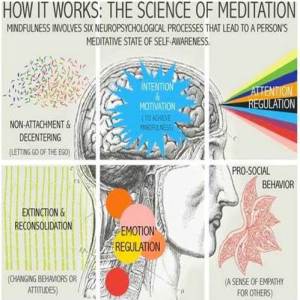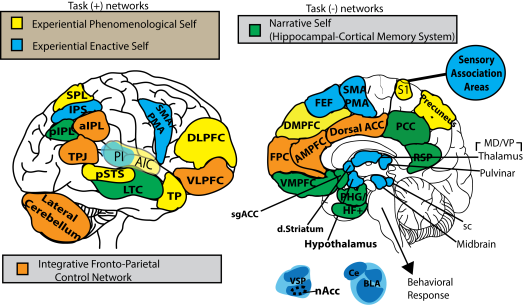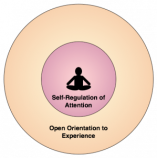 We are amidst the MINDFUL REVOLUTION, but do we have a handle on what mindfulness even is?
We are amidst the MINDFUL REVOLUTION, but do we have a handle on what mindfulness even is?
Contemporary usage of the term mindfulness has its roots in Buddhist contemplative practices that outline a systematic form of training of the mind involving meditation. In the classical Buddhist context, the term meditation is used to translate the Sanskrit term bhävana and its Tibetan equivalent, sgoms. Etymologically, the Sanskrit term connotes the notion of “cultivation,” or “causing to become” and the Tibetan equivalent, refers to “development of familiarity”. Thus, mindfulness is originally conceptualized through a framework for developing familiarity with one’s mind.
It is also helpful to note that Contemplative practice, in general, refers to a particular form of observation in which there is a total devotion to revealing, clarifying, and making manifest the nature of reality. Buddhist scholar, Alan Wallace goes into detail about the concept of “contemplation” in science in his book, “Contemplative Science“.
The word mindfulness has been literally translated from the Pali root, sati, (or Sanskrit translation, smṛti; Tibetan, dran pa), meaning “that which is remembered”. The term is closely related to the verb sarati referring to the process, “to remember”. The concept of mindfulness has its roots in the classical Buddhist Abhidhamma and is described at length in various Buddhist texts, including “The Heart of Buddhist Meditation” (Thera, 1962), the “Visuddhimagga” (the path of purification) (Buddhaghosa, 1991), and the Satipatthāna sutta (“the foundation [or presence] of mindfulness”) (Analayo, 2003). From the classical Buddhist context, views on the concept of mindfulness vary considerably (Dreyfus, 2011; Dunne, 2011), although most agree the Satipatthāna is one of the most influential texts that describes the foundation of mindfulness as a direct path for “cessation of suffering”, “awakening” or “realization”. The path includes the state of mindfulness as a critical and essential factor, but along with a set of mental processes or factors that must co-arise together. For example, the majority of schools of Buddhism describe the concept of mindfulness as one of four essential mental factors: (1) mindfulness; (2) balanced application of effort (Pali: atapi); (3) an equanimous state of concentration (Pali/Sanskrit: samadhi) free of desire (Pali: abhijha) and discontent (Pali: domanassa); and (4) a form of wisdom or “discriminating alertness” (Pali: sampajana). Also described as “clear comprehension”, some scholars will fuse sati with sampajaña (sati-sampajaña) to illustrate the compound nature of the concepts. Apart from being a basic mental factor, the state of mindfulness is also thought to have the critical quality of monitoring the development and balance of the other three faculties. Furthermore, the Buddhist definition of right mindfulness is ethically discerning, noting the distinction between wholesome and unwholesome states of mind, and then cultivating the former while rejecting the latter. Thus, mindfulness is described as a skill from the Buddhist framework that functions to maintain a continuous state of non-conceptual awareness and meta-awareness with discernment – rooted in an ethical framework.
see vol 12 (2011) of Contemporary Buddhism for some great commentary on the difficulty of operationalizing mindfulness [Link] also in a book form [Link]. Some of the articles in this volume of note are below:
- Bodhi, B., 2011. What does mindfulness really mean? A canonical perspective. Contemporary Buddhism: An Interdisciplinary Journal 12, 19 – 39.
- Dreyfus, G. (2011). “Is mindfulness present-centred and non-judgmental? A discussion of the cognitive dimensions of mindfulness.” Contemporary Buddhism: An Interdisciplinary Journal 12(1): 41 – 54.
- Dunne, J. (2011). “Toward an understanding of non-dual mindfulness.” Contemporary Buddhism: An Interdisciplinary Journal 12(1): 71 – 88.
- Williams, J. M. G. and J. Kabat-Zinn (2011). “Mindfulness: diverse perspectives on its meaning, origins, and multiple applications at the intersection of science and dharma.” Contemporary Buddhism: An Interdisciplinary Journal 12(1): 1 –
- Gethin, R. (2011). “On some definitions of mindfulness.” Contemporary Buddhism: An Interdisciplinary Journal 12(1): 263 – 279.
You may be keenly aware that there are many uses of mindfulness in secular settings and it is defined in ways that capture elements of the Buddhist dharma, but with less continuity or intensity by which it is cultivated through meditative practice and/or commitment to the dharma. In order to avoid too much confusion between contemporary and historical accounts, we need only to understand the differences in context, content, and process by which we refer to the concept.
As clinicians, researchers, and basic scientists, we are slowly operationalizing the concept of mindfulness in contemporary settings as a state, trait, and process for stabilizing the mind and developing insight into the nature of our mind – all of the mental habits (perceptual, emotional, or cognitive) that together, create our sense of self. Below, are the varied contexts mindfulness is described and an operational conceptualization from each perspective.
STATE of MINDFULNESS
This is a temporary moment of paying attention, in a particular way that is absent of emotional reactivity, cognitive evaluations or judgments, and limited to the present moment – not reflecting on the past, or projecting into the future. A momentary state of mindfulness can be induced in a volitional way that does not require one to partake in any form of meditation or have any contemplative practice background. From a clinical context, a therapist may encourage his/her patient to cultivate a STATE of MINDFUL AWARENESS, for the purpose of gaining psychological distance from one’s own maladaptive thoughts and emotions. The state of mindfulness exists variably on a spectrum of continuity and intensity. The intensity of the state relates to the concentration power and clarity of the moment. With low concentration there is high distractibility – with high concentration, there is stability. With low intensity there is dullness, torpor, and fatigue – with high intensity there is perceptual clarity and high arousal from within the phenomenological experience. The continuity of the state of mindfulness relates to the duration of the experiential state. Quite simply, the longer the duration, the longer the state – and thus, greater chance for increased intensity.
Kabat-Zinn (2005) defines mindfulness broadly in his book, “Coming to Our Senses” as:
moment-to-moment, non-judgemental awareness, cultivated by paying attention in a specific way, that is, in the present moment, and as non-reactively, as non-judgementally, and openheartedly as possible. When it is cultivated intentionally, it is sometimes referred to as deliberate mindfulness. When it spontaneously arises, as it tends to do more and more the more it is cultivated intentionally, it is sometimes referred to as effortless mindfulness.
The idea is that over time and practice, the state of mindfulness is likely, by its very nature, to arise spontaneously without effort throughout our daily life. It may not necessarily be ethically discerning as described in the Buddhist literature, in fact, it likely does not include such a characteristic during a “state-mindfulness induction”; however, through repeated practice, discernment is likely to arise, facilitate prosocial and moral thoughts/emotions – and compete with older anti-social, unethical tendencies.
TRAIT of MINDFULNESS
A trait is a dispositional characteristic of cognition, emotion, or behavior that is enduring in nature. If in fact, the state of mindfulness is a skill, then similarly to other skills, some individuals may have a particular innate capacity to culative the state more readily than others. The trait of mindfulness is measured by at least 8 different self-report measures (see Measuring Mindfulness). There is currently no good objective measurement of such a trait. Experience of formal sitting practice has been used to measure the trait of mindfulness as a proxy.
MINDFULNESS – A SYSTEMATIC FORM OF MENTAL TRAINING
Jon Kabat-Zinn stated recently in a wonderful article detailing the origins of the Mindfulness-Based-Stress-Reduction program [see Link], the term, “mindfulness” was used
“intentionally as an umbrella term to describe our work and to link it explicitly with what I have always considered to be a universal dharma that is co-extensive, if not identical, with the teachings of the Buddha, the Buddhadharma. By ‘umbrella term’ I mean that it is used in certain contexts as a place-holder for the entire dharma, that it is meant to carry multiple meanings and traditions simultaneously….” p. 290.
In this regard, one can more broadly specify mindfulness as a process, path (or method) of systematic mental training for reducing suffering and developing a sustainable healthy mind. This process can be described to involve developing core skills of Self-awareness, Self-regulation, and Self-transcendence (S-ART):
-
An unbiased awareness of self (Self-awareness),
-
An ability ty to effectively manage one’s responses/impulses (Self-Regulation), and
-
The development of a positive relationship between self and other that transcends self-focused needs and increases prosocial behavior (Self-Transcendence)
In order to put these sensitive semantic issues in proper context, I also would like to provide you with an excerpt from a paper (Is Meditation a Means of Knowing our Mental World?) written by Thupten Jinpa, Institute of Tibetan Classics, McGill University:
The word meditation in a contemporary cultural context often has the connotation of doing something special to calm the mind or to try and achieve some form of altered state of consciousness. One obvious fact that we tend to forget is that “meditation” is actually an English term and that, when applying it to convey a core element of Eastern spiritual practice, such as that of Buddhism, there might involve unrecognized conflation of meanings. In the classical Buddhist context, however, the term meditation is used to translate the Sanskrit term bhävana and its Tibetan equivalent gom (spelt sgoms). Etymologically, the Sanskrit term connotes the notion of “cultivation,” while its Tibetan equivalent gom carries the idea of developing “familiarity,” together implying the idea of some kind of repetitive process of cultivating a familiarity, whether it is with respect to a habit, a way of seeing, or a way of being. In its actual usage, however, the term gom is applied not only to the process of “cultivation” or “development of familiarity,” it is also applied to the resultant states achieved through such processes. So, in this sense, meditation can refer both to the practice of disciplined cultivation as well as the cultivated result of such a discipline. One can also extend the definition: we are all cultivating our minds in one way or another all the time. The quality of our lives reflects the ways we have cultivated our minds until now.
One MUST understand the cultural sensitivities involved in the introduction of these practices and therefore encourage you all to approach “mindfulness” and “contemplative practice” as a respectful anthropologist would treat an encounter with an indigenous culture (as Jon K-Z would say), while being careful to not unwittingly ignore or dismiss the deepest and most subtle features of such practices.
In conceptualizing mindfulness in a clinical context, in a neurphenomenological context, or in a context that is related to the nature of mind, it is repeatedly emphasized that we consider the historical and cultural context from which the term arises and clearly distinguish it from common, everyday usage, and from secular descriptions of psychological constructs that are often conflated with mindfulness. Indeed, there may very well be some functional overlap between these more common psychological constructs and our operationalization of mindfulness. Some common constructs from the psychological literature include:
Acceptance.
Acceptance refers to “just noticing,” accepting, and embracing their private thoughts and emotions, especially previously unwanted ones rather than trying to teach people to better cognitively control their thoughts, feelings, sensations, memories and other private events. Acceptance is often associated with mindfulness through the evidence-based behavioral therapy, Acceptance and Commitment Therapy (ACT) (Hayes, Srosahl, Wilson, 2003). The idea of acceptance can be found amongst most mindfulness-based interventions (MBIs). Some other MBIs include:
-
Mindfulness-based Stress Reduction (MBSR) (Kabat-Zinn, 1989) (see LINK for extensive background and overview)
-
Mindfulness-based Cognitive Therapy (MBCT) (Segal, Williams, Teasdale, 2000)
-
Dialectical Behavior Therapy (DBT) (Linehan, 1997)
-
Mindfulness-based Relapse Prevention (MBRP) (Witkiewitz, K., Marlatt, G. A., & Walker, D. 2005)
Only MBSR, MBCT, and MBRP involve formal meditation practice.
Situational Awareness (E. Langer and M.R. Endsley)
Situational awareness (SA) comes from the common usage of the term, mindfulness as the opposite of “mindlessness”. Ellen Langer describes mindfulness using situational awareness, also described by Mica Endsley. Langer states, “When we are mindful, we implicitly or explicitly (1) view a situation from several perspectives, (2) see information presented in the situation as novel,(3) attend to the context in which we perceive the information, and eventually (4) create new categories through which this information may be understood.” (Langer,1997, p.111)
Langer also likens the construct of mindfulness as the process of drawing novel distinctions. “Actively drawing distinctions keeps us situated in the present. It also makes us more aware of the context and perspective of our actions than if we rely upon distinctions and categories drawn in the past” (Langer & Moldoveanu, 2000)
Dr. Endsley draws and applies the concept from a military background – with ties even historically to The Art of War, by Sun Tzu. The air force uses SA in the context of war: rapidly relying on continuous observe-orient-decide-act looping. Endsley’s definition (1995b), “the perception of elements in the environment within a volume of time and space, the comprehension of their meaning, and the projection of their status in the near future,” (see model aside text)
Relaxation Training (includes Biofeedback-induced relaxation, progressive muscle relaxation, and the relaxation response)
see description of relaxation training for health from NIH-NCCAM [Link]
 1. Biofeedback-induced relaxation – The use of a personal computer to send audio and video signals to feedback information about physiological parameters.
1. Biofeedback-induced relaxation – The use of a personal computer to send audio and video signals to feedback information about physiological parameters.
2. Relaxation Response (H.Benson) – The relaxation response refers to the central and physiological counter response to the stress response
3. Progressive Muscle Relaxation (E.Jacobson)
PMR was originally developed by Edmund Jacobson in 1925 as a technique to gain introspective control over tension.
Models of Mindfulness
-
Hayes, 1999 – a two-component model of mindfulness in his usage of the term for Acceptance and Commitment Therapy (ACT):
Steven C. Hayes, 1999 defines mindfulness as (a) the intentional self-regulation of attention to facilitate greater awareness of bodily sensations, thoughts, and emotions; and (b) a specific quality of attention characterized by endeavoring to connect with each object in one’s awareness (e.g., each bodily sensation, thought, or emotion) with curiosity, acceptance, and openness to experience. Such a state involves an active process of relating openly with one’s current experience by allowing current thoughts, feelings, and sensations
-
Bishop et al. 2004 – two-component model of self-regulation & present-centered awareness [Link].
This model describes mindfulness as “an intentional, reflective style of introspection or self-observation”. Bishop characterizes mindfulness as the Open Monitoring form of meditation practice. This is a common characterization which is in contrast to Focused Attention meditation or concentrative meditation. The first component involves the self-regulation of attention so that it is maintained on immediate experience, thereby allowing for increased recognition of mental events in the present moment. The second component involves adopting a particular orientation that is characterized by curiosity, openness, and acceptance.
-
Shapiro, Carlson, et al., 2006 – Three-axiom model (Intention-Attention-Attitude) – a cyclic process of internal behaviors that occur continuously and simultaneously [Link]
Shaprio et al. describe, “Building on these behaviors (IAA), we propose a model of the potential mechanisms of mindfulness, which suggests that intentionally (I) attending (A) with openness and non-judgmentalness (A) leads to a significant shift in perspective, which we have termed reperceiving. We believe reperceiving is a meta-mechanism of action, which overarches additional direct mechanisms that lead to change and positive outcome. We highlight four of these additional mechanisms: (1) self-regulation, (2) values clarification, (3) cognitive, emotional, and behavioral flexibility, and (4) exposure. These variables can be seen as both potential mechanisms for other outcomes, such as psychological symptom reduction, or as outcomes in and of themselves.
-
Brown, Ryan, and Creswell, 2007 – Proposed mechanisms of Insight, exposure, non-attachment, enhanced mind-body functioning [Link]
Brown et al. define mindfulness as, “a receptive attention to and awareness of present events and experience”. In addition, they propose a number of characteristics that make up mindfulness: 1) clarity and flexibility of non-discriminatory, non-conceptual awareness; 2) empirical stance towards reality; 3) present-oriented consciousness; 4) stability or continuity of awareness and attention
-
Garland et al., 2011 – Mindful coping Model – Proposed pathways for positive Reappraisal of Stress [Link]

Garland states, “the practice of mindfulness (which involves repeated placement of attention onto an object while alternately acknowledging and letting go of distracting thoughts and emotions) engenders a transitory state of mindfulness, which, when engaged repeatedly over time, may accrue into trait or dispositional mindfulness”. Garland proposes that mindfulness practice may facilitate one such strategy, positive reappraisal, i.e., the adaptive process through which stressful events are re-construed as benign, beneficial, and/or meaningful.
-
Grabovac, 2011 – Buddhist Psychological Model [Link]
Andrea Grabovac elaborates upon her model in depth on her blog [Link]. She breaks mindfulness down into a simplified process of self-regulation of attention and open orientation to experience
-
Vago & Silbersweig (2012) – Self-Awareness, Self-Regulation, and Self-Transcendence (S-ART) [Link]
Our interpretation of mindfulness as a path for reducing suffering and sustaining a healthy mind provides an empirical framework of self-awareness,regulation, and transcendence (S-ART) to illustrate a method for becoming aware of [and familiar with] the conditions which cause [and remove] distortions or biases in the individual‘s construction of his or her external or internal experience. Through training in FA, OM, and EE styles of meditation, a sustainable healthy mind is proposed to be supported – reducing maladaptive emotions and cognitions common to most ordinary experience, such as lustful desire, greed, anger, hatred, worry, etc., increasing pro-social dispositions (e.g., compassion, empathy, forgiveness) towards self and other, reducing attachments to thoughts and feelings, and removing biases inherent in habitual forms of cognition.
Although the state of mindfulness has its roots in a number of specific processes related to memory and attention, the concept is more broadly applied as a process/method for stabilizing and developing insight into habits of mind. This process can refer to the quality with which one brings awareness to objects of attention, and in other contexts as the path for reducing suffering and achieving non-dualistic forms of experience. As we continue to investigate mindfulness as an integrative process and method and distinguish the method from the state of awareness, we will better grasp the subtleties of the concept and be able to measure it more effectively and objectively than through self-report measures. Thus, our operationalization of mindfulness does not come from any single process of memory or attention but is best conceptualized through a systems-based framework for a number of different cognitive, psychological, and biological processes involved in cultivating mindfulness as a state and trait and through a systematic form of training the mind that is rooted in an ethical framework. We can then better understand any other contemporary form of mindfulness as an adaptation of this conceptualization and which differs in context, content, and process.
Six Neurocognitive Skills by which Mindfulness facilitates S-ART: 
-
1) Intention & Motivation
-
2) Attention Regulation (stability, control, and clarity)
-
3) Emotion Regulation (response inhibition & equanimity)
-
4) Extinction and Reconsolidation (of sensory-affective-motor scripts/schemas/biases)
-
5) Prosociality (Empathy, Theory of Mind – Ethical framework in social cognition)
-
6) Meta-awareness (De-centering/observing ego/ psychological distancing, non-attachment)
Networks of Self-processing modulated by S-ART:

see full blog on S-ART model here: [Link]
Commentaries on the Concept of Mindfulness:
Thanissaro Bhikkhu on Mindfulness [Link]
Jon Kabat-Zinn on Mindfulness:
Shinzen Young speaking at the Functional Neuroimaging Lab:
David Vago speaking on the neurobiology of mindfulness:
Bob Sharf on Mindfulness in a cultural context
Mindfulness in Medicine, Healthcare, and Society
Feel free to comment and Stay tuned for future updates






Mindfulness as elixir? Mindfulness as mana?
http://speculativenonbuddhism.wordpress.com/2011/07/03/elixir-of-mindfulness/
LikeLike
[…] What is Mindfulness? […]
LikeLike
I think mindfulness is a mental skill that brings back our attention to object; and it is one type of mental factors, that’s it! If you say how many functions or characters does the mindfulness have ? for me, that is another question, because it depends on our practice, different mental states involve different mindfulness skill, for instance, meditate on impermanence and emptiness come up with different mindfulness, because it is parts of awareness and intelligence, always!
LikeLike
one other thing to keep in mind when conceptualizing mindfulness is its use as a state or trait. As a state of mindfulness, it can be conceptualized as Rinchen mentions…as a quality of the mind or mental faculty that co-arises with 3 other qualities: diligence, wisdom, and equanimous freedom from desire and discontent. In this context, the state of mindfulness is a form of awareness and can be more appropriately labeled, “mindful awareness” —- The four qualities can be thought of as qualities that compose a method for developing the mind – such a method can also take the broader definition of mindfulness as a means to developing and sustaining a healthy mind. This method is also described to be applied towards four central domains: the body, feeling states, ethical qualities of mind, and any object of mind that arises.
so when I say I am mindful…it can translate to the following:
Here I am mindfully aware….in each breath…before I even know it…my attention is expanded – effortlessly conserving cognitive resources – it is more diffuse and alert to a higher resolution of my phenomenal experience – I am efficiently monitoring and evaluating – rapidly discriminating features of the environment as novel or familiar – maintaining equanimity while inhibiting impulses without awareness – the clarity of my senses is intense and unbiased – providing stable emotion to feed the exhale and awareness of the my surroundings without fixating on any thought or sensation.
LikeLike
This is a great inspiring article. I am pretty much pleased with your good work. You put really very helpful information. Keep it up. Keep blogging. Looking to reading your next post.
LikeLike
[…] What is Mindfulness? […]
LikeLike
Hey great stuff, thank you for sharing this useful information and i will let know my friends as well.
LikeLike
[…] I elaborate a bit more on dismantling mindfulness here [Link] […]
LikeLike
[…] What is Mindfulness? – Contemplative Mind in Life – WordPress.com […]
LikeLike
[…] What is Mindfulness? – Contemplative Mind in Life – WordPress.com […]
LikeLike
[…] our theoretical models, (1(link is external), 2(link is external)) by which we propose mindfulness(link is external) functions as a systematic form of mental training, we break down the process of “selfing” into […]
LikeLike
[…] What is Mindfulness? – Contemplative Mind in Life – WordPress.com […]
LikeLike
[…] What is Mindfulness? – Contemplative Mind in Life – WordPress.com […]
LikeLike
[…] What is Mindfulness? – Contemplative Mind in Life – WordPress.com […]
LikeLike
[…] What is Mindfulness? – Contemplative Mind in Life – WordPress.com […]
LikeLike
[…] What is Mindfulness? – Contemplative Mind in Life – WordPress.com […]
LikeLike
[…] What is Mindfulness? – Contemplative Mind in Life – WordPress.com […]
LikeLike
[…] What is Mindfulness? – Contemplative Mind in Life – WordPress.com […]
LikeLike
[…] What is Mindfulness? – Contemplative Mind in Life – WordPress.com […]
LikeLike
[…] What is Mindfulness? – Contemplative Mind in Life – WordPress.com […]
LikeLike
[…] What is Mindfulness? – Contemplative Mind in Life – WordPress.com […]
LikeLike
[…] What is Mindfulness? – Contemplative Mind in Life – WordPress.com […]
LikeLike
[…] What is Mindfulness? – Contemplative Mind in Life – WordPress.com […]
LikeLike
“Only MBSR, MBCT, and MBRP involve formal meditation practice.” Perhaps, that is a broad claim or a misleading statement. Formal meditation practice certainly predated and extends beyond these protocols, in many cultures and traditions. Would including the author or authors of this article help me understand where this point of view comes from? Bias and ego have always existed even in monasteries and health professions, and ill worded comments like this might lead some people to feel aversion to these particularly helpful interventions.
LikeLike
Hi Nadine. I am sorry you feel mislead. It appears you may be misunderstanding the statement or at the very least taking it out of context. When I stated, “only MBSR, MBCT and MBRP involve formal meditation practice” – this is in reference to the “mindfulness-based intervention” – the contemporary adaptation of historical Buddhist ideas and practices into secular clinical settings. In that context, only those specific clinical interventions (MBSR, MBCT and MBRP) involve formal sitting meditation – the majority of other clinical interventions that claim to involve mindfulness do not typically involve formal sitting meditation, but rather attempt to facilitate a state of mindfulness that is temporary – this can be conceptualized as a “state induction” where continuity of the state longer than a few moments is not expected or encouraged necessarily – but rather the induction technique is used to provide a taste of what it feels like to focus one’s awareness on the present moment with added qualities of “openness”, “curiosity”, “interest”, and “non-judgment”. I do hope that clarifies a little. And to be more clear… formal meditation practice originated long before the mindfulness-based intervention. 🙂
LikeLike
[…] What is Mindfulness? – Contemplative Mind in Life – WordPress.com […]
LikeLike
[…] What is Mindfulness? – Contemplative Mind in Life – WordPress.com […]
LikeLike
[…] What is Mindfulness? – Contemplative Mind in Life – WordPress.com […]
LikeLike
[…] What is Mindfulness? – Contemplative Mind in Life – WordPress.com […]
LikeLike
[…] What is Mindfulness? – Contemplative Mind in Life – WordPress.com […]
LikeLike
[…] What is Mindfulness? – Contemplative Mind in Life – WordPress.com […]
LikeLike
There is so much in this article that I would never have thought of on my own. Your content gives readers things to think about in an interesting way
LikeLike
I have personally practiced MBSR and do it on a daily basis, starting from an early morning meditation. Mindfulness is becoming popular in the western part of the world and it is hopefully going to give something positive to new generations. It is very interesting to me the approach towards kids at school.
LikeLike
[…] Contemplative Mind in Life, A Global Collection of Mindfulness and Meditation Research Resources: What is Mindfulness? […]
LikeLike
Do you have any suggestions on research to give parents who push back against mindfulness being taught in schools, due to Buddhist origins? (Asking as a School Adjustment counselor).
LikeLike
Great Question! There remains very little empirical evidence (as of Sept, 2020) for the benefits of specific mindfulness programs in k-12. check out a few of the programs with the most evidence: https://www.mindfulschools.org/, https://mindup.org/, https://mindfulnessdirector.org/. I am cautious to recommend programs that have not been tested empirically, but to suggest that they be used as pilot programs. Here is a recent report from NPR urging caution as well: https://www.npr.org/2020/02/27/804971750/schools-are-embracing-mindfulness-but-practice-doesnt-always-make-perfect. So..my view is that while mindfulness programs have demonstrated efficacy in improving health outcomes in adults, across the lifespan, the evidence remains unclear in any definitive way. Programs should be tested as pilot programs and research should be done to examine the safety, efficacy, and determine the extent to which it can improve academic, social, and emotional outcomes in comparison to gold-standard or actively controlled curriculae.
LikeLike
[…] Denne definisjonen er bevisst formulert slik at den er lett å forske på, fordi alle delene av den har også klare definisjoner. Det gjør også at det blir lettere å undervise. En hjerneforsker som er inspirert av Shinzen er Dave Vago, som har sin egen utmerkede samling av perspektiver på mindfulness. […]
LikeLike